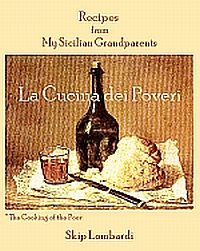Living on $42.00 per Week-Day 3
July 18th, 2007Total food stamp funds remaining: $17.87.
Lunch Tuesday:
Last night’s supper became the basis for lunch today: we supplemented the leftover chunks of potato salad, tomato slices , and about half a cup of ceviche with an additional boiled potato, five leaves of torn Romaine, and one more tomato to yield a lunch-sized salad for two. The marinades, juices, and herbs from the three dishes were almost adequate as a dressing, but we added a little more vinegar and another spoonful of olive oil. Along with the salad, we had some of our day-old BJ’s rolls.
At this point, our rolls are becoming a little long in the tooth, but we know a trick to revive them: we simply pass them quickly under running water, shake them off and toss them into the toaster-oven at approximately 375 F. for five to ten minutes. Voila!! nearly fresh rolls.
As we go along with this experiment, we’re seeing a theme emerge: maintaining a reasonable diet on such a limited budget requires significant thought and planning. And we admit it—we have another advantage: we truly enjoy the process. For example, on Sunday, while cooking potatoes for our dinner salad, we added a few extras, just to have them available as ready-to-use components of other dishes later in the week. So it was easy today to augment leftovers from last night with another potato.
We also had carrots in the fridge before we started. We par-cooked two of them for three minutes with the potatoes even though we had no specific use in mind. Now, they’re available when we make a quick soup or perhaps for a carrot salad.
Our endeavors have not been limited to shopping and cooking. We’ve also been at our desks—reviewing other blogs and news sources concerning the “Food Stamp Challenge.” As part of an organized program (May 15-21, 2007), several members of Congress and numerous bloggers across the country attempted to survive on the weekly allotment of $21.00*.
We have observed something noteworthy: many of the participants didn’t cook. They simply went to the grocery store and bought the cheapest food they could find. It’s laudable that many of them bought apples, bananas, salad ingredients, and canned tuna fish, but there seemed to be no underlying strategies, and they found that they quickly depleted their weekly allowance. We said at the outset we had an edge as foodies who know how to cook. And unless you live in an area with markets that sell low-cost vegetables, following our program would be an even bigger challenge. We feel that to make the experiment work, and for that matter to make food stamps work in the real world, one must cook, or be part of a household or social group where someone else cooks—from scratch.
Of course $21.00 per week for food is Spartan by any American’s definition. But we’re not so married to our liberal ideals that we think increasing the weekly allowance is the whole answer (although it’s a good start). In order to succeed, no matter how large the budget, we feel that part of the food stamp program should involve some kind of education. At a minimum, the program needs an instructional component that shows food stamp recipients how to select, prepare, and store fresh food. Bilingual pamphlets won’t do it—we mean instruction: free classes, demos in schools, DVDs, TV—anything to show people how to make appealing and healthy food on a shoestring. Oprah and Cristina, are you listening?
We feel, for example, that those bags of pre-washed, pre-cut lettuces are among the worst ways to use our food budget (sorry, Rachael Ray.) At mainstream grocery stores here in Sarasota, a bag of pre-washed lettuce would deplete an individual’s weekly food stamp budget by nearly 20%. On the other hand, a head of Romaine—even if it is slightly wilted—costs $1.00 at the open produce market. We revive it by simply cutting a small piece from the base and standing the head upright in an inch or so of water, (in a recycled yogurt container). We place the lettuce on the shelf of the fridge door, like a bouquet (We use the same trick to keep our parsley from wilting.)
We think it is legitimate to ask: do most people with food insecurities own salad-spinners or know how to wash greens and then, know how to store them? And we’ve not even arrived at the point of food preparation! A lot of people don’t know how to dress a salad with oil and vinegar, how to sweat collards, or how to stir-fry sliced zucchini.
Supper Tuesday:
Once again, we brought out our Wal*Mart rotisserie chicken, divided the remains in two, so we each had a serving of breast meat and a wing (a less elegant version of the “Statler breast”). We simmered two of our sweet potatoes till tender, slipped off their skins, and mashed them with garlic, a little salt, and coarsely chopped parsley. An apple found in the fridge became a fresh chutney with green bell pepper, ginger root, lime rind, lime juice, and a dash of chili sauce.
* The weekly food stamp allowance varies from state to state—on the Web we’ve found allotments ranging from $19 to over $24 per week. $21 is our Florida figure.
Links to the rest of the posts in our series:
Living on $42.00 Per Week—the Challenge
Living on $42.00 Per Week—Day 1
Living on $42.00 Per Week—Day 2
Living on $42.00 Per Week—Day 4
Living on $42.00 Per Week—Day 5
Living on $42.00 Per Week—Day 6
Living on $42.00 Per Week—Day 7
Living on $42.00 Per Week—Summary
Living on $42.00 Per Week—Redux



